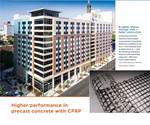Entertainment complex creates glass-fiber reinforced concrete panel illusion
MVRDV has constructed two abstract buildings in an South Korean entertainment complex that use glass-fiber reinforced concrete to mirror facades of surrounding buildings.
Architecture studio MVRDV (Rotterdam, the Netherlands) has completed construction on The Imprint, a two-building addition to an entertainment complex in Seoul, South Korea. The new buildings house a nightclub and an indoor amusement park.
The windowless abstract structures use glass-fiber reinforced concrete panels to mirror the façades of surrounding buildings, which are “imprinted” as a relief pattern that appears to drape over the buildings.
“By placing, as it were, surrounding buildings into the facades of our buildings and in the central plaza, we connect The Imprint with the neighbors,” says Winy Maas, principal and co-founder of MVRDV. “This ensures coherence.”
To create the illusion, many of the more than 3,800 panels are unique and had to be created from individual molds. According to MVRDV, the construction required molds to be individually produced using MVRDV’s 3D modelling files from the design phase. Once installed, the panels were painted white or gold to emphasize the relief in the design.
The effect is impressive and blurs the lines between architecture and art.
Related Content
-
Infinite Composites: Type V tanks for space, hydrogen, automotive and more
After a decade of proving its linerless, weight-saving composite tanks with NASA and more than 30 aerospace companies, this CryoSphere pioneer is scaling for growth in commercial space and sustainable transportation on Earth.
-
JEC World 2024 highlights: Thermoplastic composites, CMC and novel processes
CW senior technical editor Ginger Gardiner discusses some of the developments and demonstrators shown at the industry’s largest composites exhibition and conference.
-
Carbon fiber, bionic design achieve peak performance in race-ready production vehicle
Porsche worked with Action Composites to design and manufacture an innovative carbon fiber safety cage option to lightweight one of its series race vehicles, built in a one-shot compression molding process.






